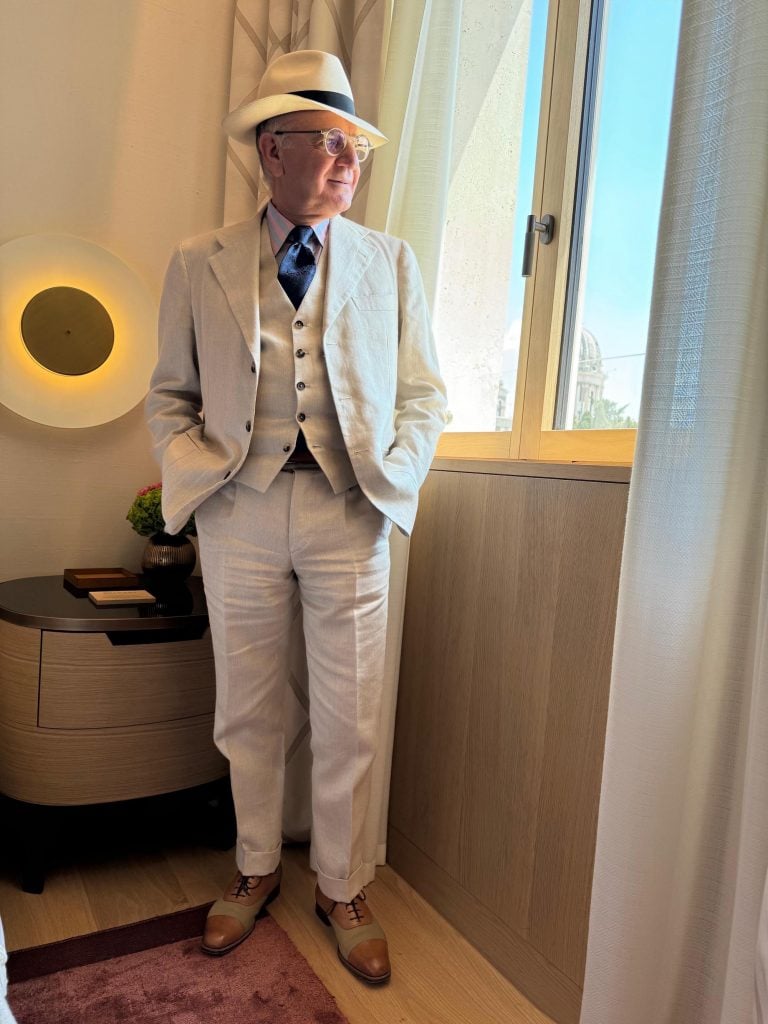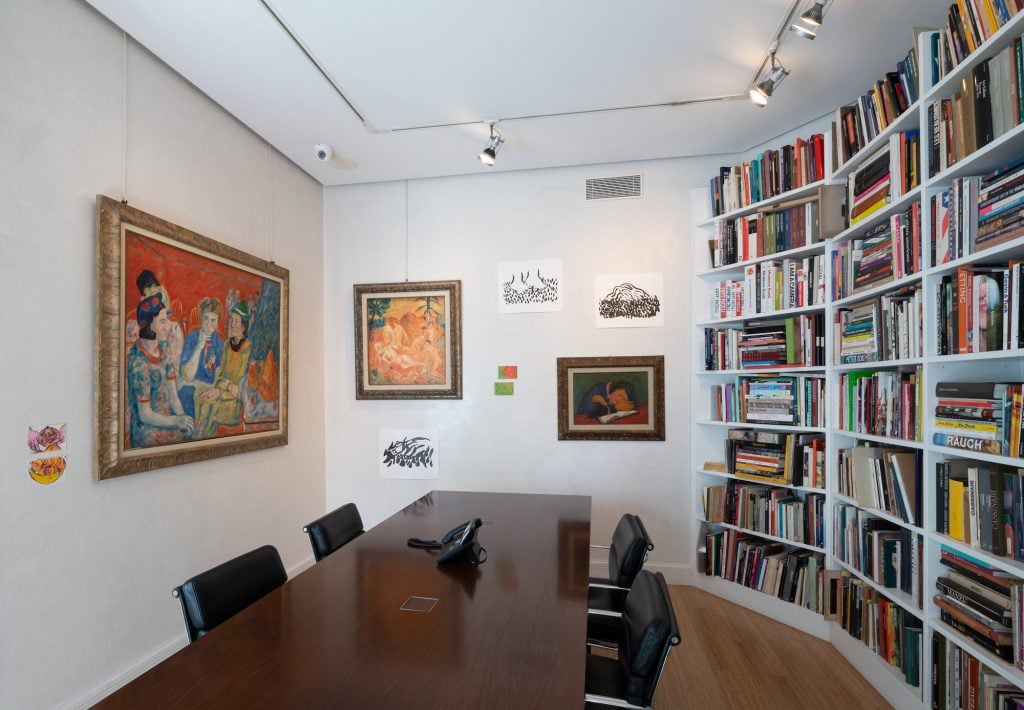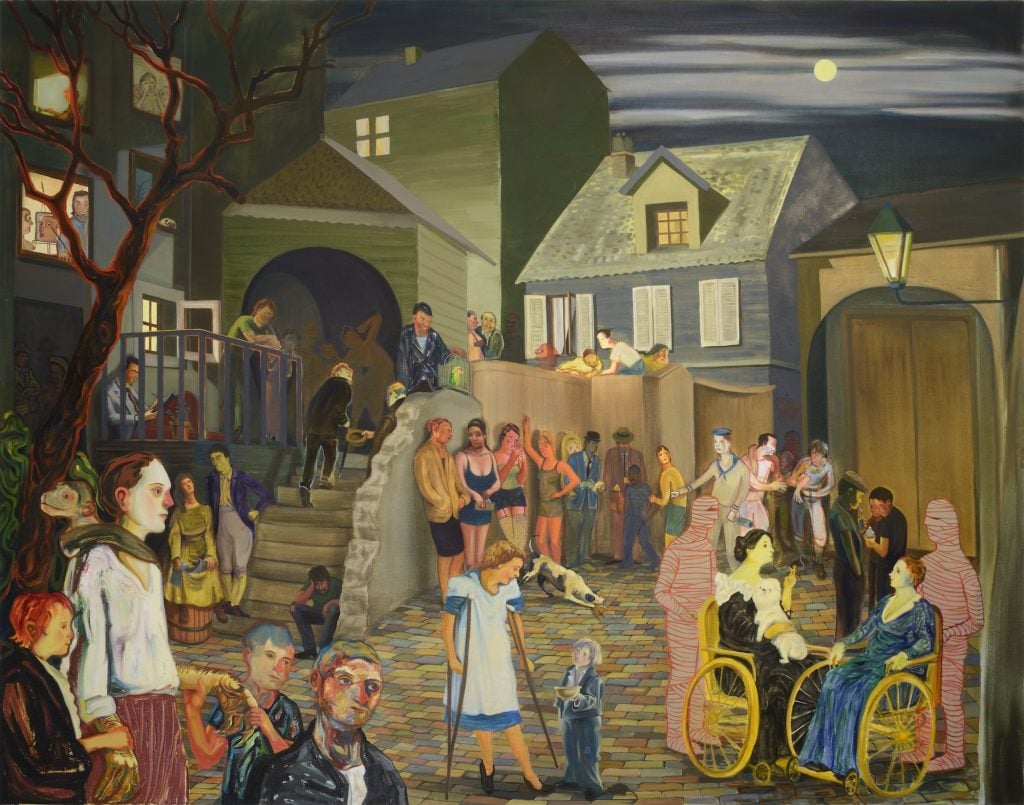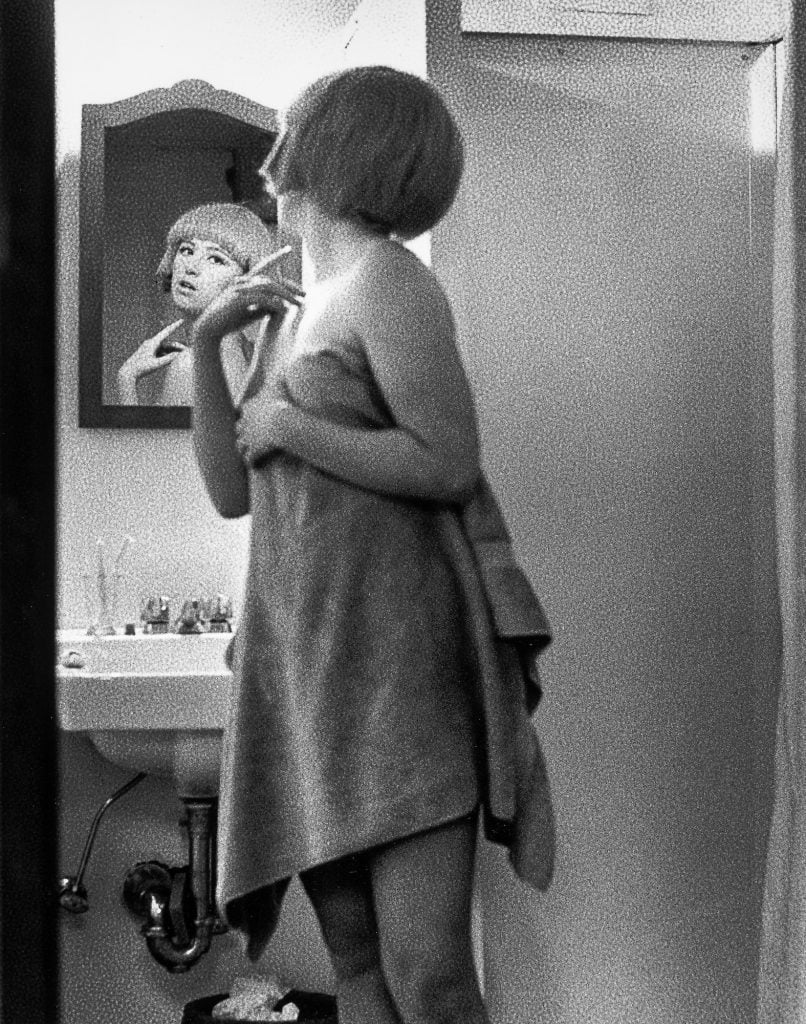Art World
Italian Collector Giuseppe Iannacone on the Perils of ‘Serial Accumulation’
"A masterpiece by a lesser-known artist is more valuable to me than a minor work by a historically celebrated artist," says the esteemed Italian collector.

"A masterpiece by a lesser-known artist is more valuable to me than a minor work by a historically celebrated artist," says the esteemed Italian collector.

Eileen Kinsella

Giuseppe Iannaccone’s unique approach to collecting might surprise you, but it developed organically, with careful research and consideration. The Italian lawyer has a two-pronged collection, one focused on inter-war Italian art; the other part is dedicated to contemporary art, with works by Nicole Eisenmann, Laura Owens, and Cindy Sherman.
However, it would be incorrect, in Iannnaccone’s view, to think of these as distinct arenas. “[It is] one big container of timeless stories, linked by a common thread that creates a dialogue between them,” the collector says. “Stories of life lived, regardless of their historical era, speak of the depth of the human soul, its joys, and its weaknesses.”
Born in Southern Italy in 1955, Iannaccone eventually moved north to Milan. Around the time he launched his own law firm, in the early 1990s, art and the idea of collecting grabbed his attention.
We caught up with Iannaccone, whose collection now numbers into the hundreds, to learn more about how he continues to maintain this dynamic approach to art collecting, as well as his thoughts on the art market, where to buy and find meaningful art, and how to make a collection truly timeless.

Photo by Studio Vandrasch. Image courtesy Collezione Giuseppe Iannaccone.
What was your first purchase?
I discovered art in response to a deeply personal need. At the beginning of the 1990s, I was a young lawyer at the beginning of my career. I had just started my own law firm and I was already working on very important cases. This of course boosted my reputation and allowed me to grow, but it generated a lot of worries because I was not experienced enough to handle such important cases. Pretty soon, those sleepless nights took me into the arms of art. I started to dedicate some time to visiting galleries and artist studios in Milan, Italy, with a friend of mine—and art became my cure, it saved my equilibrium. Art was a distraction, but it soon became a passion and, from being the “crutch for my soul,” as I liked to define it at the time, it became an inseparable life companion.
I started studying and reading art history books, and I bought my first artwork: it was a 1987 painting by Claudio Bonichi, Sirena Ferita. It depicts a faun, a man in a mask, in the Venetian lagoon, lifting a wounded mermaid with a harpoon. Some people say he had just killed her; I always thought he was lifting her up to save her. This is when I understood how a work of art originates from the artist’s idea but then lives and takes on a meaning only in the eye of the observer.
I still have that painting and I will never give it away, because it is my first painting. I bought it because I liked it and maybe because Bonichi was Scipione’s grandson. For me, Scipione at that time was like saying today, “I’d like to have a Picasso,” and today I am proud to say that I have the biggest collection of Scipione’s works.

Photo by Studio Vandrasch. Image courtesy Collezione Giuseppe Iannaccone.
You have an interesting niche with the historic artists and the contemporary. Tell us more about these twin focuses. How are they unique, similar, or complementary to each other?
My collection is composed of two parts: the exploration of Italian art between the two World Wars and the investigation of contemporary art from the late 1970s to the present. The first part focuses on outsider artists who distanced themselves from the Italian art scene dominated by Margherita Sarfatti’s official art. These expressionist artists, forgotten up until my collection [began], used color and deliberate form alteration to reveal the deepest human emotions of the time, thus breaking away from “Novecento Italiano” (Italian 1900s) canons.
The second part of my collection, which I started in the early 2000s, is driven by the same passion for art that reflects the human soul. It includes works by contemporary artists, from Cindy Sherman to emerging talents of the new millennium, all characterized by a lyrical and poetic vision of human existence.
Though separate in time, these two parts form a cohesive whole and the thread that unites them is the focus on human expression. Guided by my sensitivity, every piece in my collection acts as a magnifying glass for humanity, exploring the hopes, concerns, joys, and daily lives of people, both past and present. Times change, artists adapt to new realities, but the human heart does not change, and so I discern a common poetic component in every artistic era.

Nicole Eisenmann, Beasley Street (2007). Image courtesy the artist, Hauser & Wirth and Collezione Giuseppe Iannaccone. © Nicole Eisenman. Photo by Studio Vandrasch.
Given that the contemporary art world is so active nowadays with a constant stream of auctions, international art fairs, and gallery openings, how do you find out about new artists or keep up with those you like? How do you filter information?
A collection aiming to explore contemporary humanity must grow at the pace of reality, constantly evolving and requiring ongoing attention. My curator, Daniele Fenaroli, and I keep ourselves updated on the art world and market through subscriptions to art magazines, both Italian and international. We follow previews of fairs and exhibitions daily, ensure we don’t miss any auctions, visit as many fairs as possible, and actively search social media for emerging artists.
For modern art, my research is guided by art history books, by visiting dedicated exhibitions, and by fostering relationships with private collectors and the heirs of the artists. For contemporary art, the challenge (and thrill) lies in acquiring a masterpiece before it is recognized by museums or art historians. Acquiring contemporary art relies heavily on networking and staying informed. I receive hundreds of alerts and previews from top galleries and auction houses worldwide, from prestigious institutions to small local entities that often surprise me with their quality and dedication to emerging artists. Daily phone calls with industry insiders also provide invaluable advice and insights on new talents.

Cindy Sherman, Untitled Film Still, 1977 (#2). Image courtesy the artist, Hauser & Wirth and Collezione Giuseppe Iannaccone. © Cindy Sherman.
When something captures our attention, we delve into the artist’s poetic vision and ask ourselves if their work adds a new chapter to art history. I prioritize acquiring significant works over merely collecting famous names. This philosophy applies to both parts of my collection: a masterpiece by a lesser-known artist is more valuable to me than a minor work by a historically celebrated artist. This conviction drives me to focus on pieces that evoke a deep poetic resonance, ensuring they contribute meaningfully to the history of art.
How has your collecting philosophy changed over time?
Over time, my philosophy of collecting has evolved, yet remains rooted in a deep appreciation for the artist’s poetic drive—their impulse to capture the human experience. Initially, my choices were often criticized as being driven by emotion rather than financial strategy. However, I take pride in these decisions, as they reflect my sensitivity and commitment to the artists’ visions.
I have recently observed a shift in the art world towards serial accumulation rather than true collecting. Many follow market trends, impulsively acquiring works deemed must-haves, often without deeper understanding. In contrast, my approach to collecting is guided by a coherent vision that seeks to identify and preserve artworks that contribute to the ongoing narrative of art history. I remain dedicated to works that resonate with me beyond any trends.
While my focus remains on the poetical and emotive aspects of art, I’ve recently recognized the social significance of my collection, which has grown to include many pieces that feature strong female presence—among others, works by Toyin Ojih Odutola, Somaya Critchlow, Nicole Eisenmann, Lynette Yiadom-Boakye, and Laura Owens—and pressing global social themes, reflecting the complex and often contradictory nature of human existence.
Artists have a unique ability to open dialogues on fundamental rights and social justice, using their mediums to raise awareness and inspire collective action. I intend to leverage this aspect to support social causes, ensuring that the collection not only reflects the human experience but also contributes to positive change.
In essence, my philosophy has deepened: I continue to honor the artist’s poetic journey while increasingly acknowledging and embracing the social impact of their work.
Where do you buy art most frequently?
I frequently acquire works of art from key players in the market, including top galleries and auction houses worldwide. Both avenues are essential, but when it comes to acquiring works by new or young artists, I primarily rely on galleries. These institutions are fundamental to the art system, serving as pillars that support and believe in the work of their artists. Good collecting practices should not overlook their crucial role, except when dealing with artists who are unknown or not yet represented by a gallery.
The two parts of my collection: 1930s art and contemporary art. Each requires different approaches in terms of research, market, and acquisition methods. For 1930s masterpieces, the process is precise and measured, involving the study of catalogues and attending dedicated exhibitions. This helps me locate desired works in various collections, facilitating negotiations for their acquisition.
I also obtain pieces from private collectors and the heirs of the artists from the 1930s. These heirs often seek me out, recognizing my commitment to preserving and valuing their relatives’ work.
Attending major art fairs is also essential for me. These events offer high-quality works and the chance to discover emerging trends and artists, ensuring my collection remains dynamic and reflective of the ever-evolving human experience.
Is there a work you regret not purchasing?
I often think about the artworks I desired but couldn’t acquire for various reasons. Especially in my early years as a collector, once I identified a masterpiece, I would spend hours trying to convince collectors to part with it or involve gallerists in the search for the piece and its owners. Not every effort was successful. For example, I once pursued Scipione’s Risveglio della bionda Sirena, but at the time, the asking price was too high for me. It eventually became part of the Cerutti Collection and now resides in the magnificent Castello di Rivoli. I only surrender to public institutions, as their role is to preserve art for everyone. I also longed for a sculpture by Manzù, a true masterpiece, but I still struggle to find one of the right quality and price.
What is your favorite work in your collection?
All the artworks in my collection are precious treasures to me and it is hard to choose a favorite, since each of them has a specific history and message. There are, of course, some works I am most attached to due to the moment of their acquisition or the artist’s poetic vision. For example, there is Untitled Film Still #2 by Cindy Sherman, a revolutionary artist for her time, particularly regarding her poetic exploration of women. And then I would also like to mention Tiresia by Jem Perucchini, who, in a very contemporary manner, draws inspiration from a past era that reminds me of my classical studies.
What work do you have hanging above your sofa? What about in your bathroom?
The artworks not displayed in the spaces of my law firm are either in storage, on loan to cultural institutions, or in my private residences. However, no piece stays in storage or the same place for too long, as continuous exhibitions and international loans keep my collection in constant motion. I firmly believe that collecting art cannot be a selfish endeavor: collecting is about exploring oneself without the presumption of keeping these emotions to oneself; that is why I share the pieces of my collection with the public through open exhibitions.
At the moment, however, above my sofa, there is Nicole Eisenman’s Beasley Street, a piece I am very attached to and that I courted for years. I have always thought however that artworks know where they are meant to end up, in which collection, and with which companions their poetic essence will resonate best. \
In the bathroom, there is a beautiful work by Hernan Bas, River Crossing (St. Christopher), one of the first works by the artist to arrive in Italy.
Furthermore, I keep Untitled by Laura Owens above my bed, the most intimate place for me.
Learn more about the collection of Giuseppe Iannaccone here.